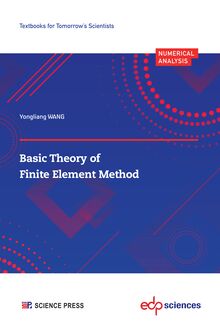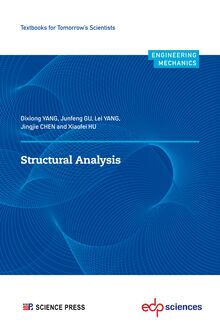Mechanics of Materials , livre ebook
502
pages
English
Ebooks
2024
Obtenez un accès à la bibliothèque pour le consulter en ligne En savoir plus
Découvre YouScribe en t'inscrivant gratuitement
Découvre YouScribe en t'inscrivant gratuitement
502
pages
English
Ebooks
2024
Obtenez un accès à la bibliothèque pour le consulter en ligne En savoir plus
Publié par
Date de parution
24 juin 2024
Nombre de lectures
1
EAN13
9782759832002
Langue
English
Poids de l'ouvrage
30 Mo
Mechanics of materials is an important introductory course that aims to provide fundamental theories for the design of engineering structures. As a prerequisite to further studies on in mechanics, this course has received significant attention to become nowadays essential and compulsory for undergraduate students majoring in engineering. The Department of Engineering Mechanics of Dalian University of Technology is a leading institute in the field of computational mechanics and engineering science in China, and has grained substantial experience in the teaching of Mechanics of materials. Authors of this book presents their core teaching materials which have distinctive features in the combination of computer science and engineering, and of theory and practice.
CHAPTER 1
Introduction to Mechanics of Materials ............................. 1
1.1Introduction ............................................ 1
1.1.1Strength, Stiffness, and Stability ....................... 1
1.1.2 Research Objects of Mechanics of Materials ............... 2
1.2 Basic Assumptions of Mechanics of Materials ................... 3
1.2.1 Assumption of Continuity ............................ 3
1.2.2 Assumption of Homogeneity ........................... 3
1.2.3 Assumption of Isotropy .............................. 3
1.2.4 Assumption of Infinit esimal Deformation ................. 3
1.3External Force, Internal Force and Stress ...................... 4
1.3.1External Force ..................................... 4
1.3.2Internal Force and Method of Section.................... 5
1.3.3Stress............................................ 6
1.4Displacement, Deformation, and Strain ........................ 7
1.4.1Displacement and Deformation......................... 7
1.4.2Strain ........................................... 7
1.5 Basic Patterns of Deformation of Prismatic Bar ................. 9
1.5.1 AxialTension and Compression ........................ 9
1.5.2 Shear............................................ 9
1.5.3Torsion .......................................... 9
1.5.4Bending .......................................... 9
PROBLEMS.................................................10
CHAPTER 2
Axial Tension and Compression .................................. 13
2.1Introduction ............................................ 13
2.2 Axial Forces and Axial Force Diagrams ........................ 13
2.2.1Normal Force ...................................... 14
2.2.2 Axial Force Diagram ................................ 15
2.3 Stress in an Axially Loaded Bar ............................. 17
2.3.1 Stresses on Cross Section............................. 17
2.3.2 Stresses on Oblique Section........................... 18
2.3.3Saint–Venant Principle ............................... 20
2.4Mechanical Behaviour of Materials Under Tension and Compression . . 22
2.4.1Introduction of Tensile and Compressive Tests ............. 22
2.4.2Mechanical Behaviour of Materials Under Tension .......... 24
2.4.3Mechanical Behaviour of Materials Under Compression ...... 29
2.5Strength Condition of Axially Loaded Bar ..................... 32
2.6Deformation of Axially Loaded Bar........................... 37
2.7Statically Indeterminate Problems of Axial Tension and Compression . 43
2.7.1Analysis of Statically Indeterminate Problem in Tension and Compression ................................... 43
2.7.2Assembly Stress .................................... 48
2.7.3Thermal Stress..................................... 50
2.8 Stress Concentration ...................................... 53
PROBLEMS.................................................54
CHAPTER 3
Shearing in Connections ........................................ 65
3.1Introduction ............................................ 65
3.2Strength Check of Shearing Deformation in Connections ........... 66
3.3Strength Check of Bearing Deformation ....................... 68
PROBLEMS.................................................74
CHAPTER 4
Torsion..................................................... 79
4.1Introduction ............................................ 79
4.2Internal Torque and Internal Torque Diagram ................... 80
4.2.1Twisting Couple on a Transmission Shaft................. 80
4.2.2Internal Torque and Torque Diagrams ................... 81
4.3 Pure Shear, Shearing Stress, Hooke’s Law in Shear Situations ....... 83
4.3.1 Shear Stress on Cross Sections of a Thin-Walled Tube Induced by Torsion........................................ 83
4.3.2Shearing Stress..................................... 83
4.3.3Hooke’s Law in Shearing ............................. 84
4.4 Shear Stress in a Circular Shaft ............................. 85
4.4.1Calculation of Shear Stress............................ 85
4.4.2Stress on Oblique Plane of a Circular Shaft Subjected to Torsion........................................ 91
4.4.3Strength Design .................................... 94
4.5Torsional Deformation of a Circular Shaft and Stiffness Design ...... 96
4.5.1Torsional Deformation of a Circular Shaft ................ 96
4.5.2Stiffness Design .................................... 96
4.6Statically Indeterminate Shaft in Torsion ...................... 100
4.7 The Strength of Helical Springs.............................. 104
4.8 Torsion of Non circular Shafts ............................... 106
4.8.1 Free Torsion and Restrained Torsion .................... 106
4.8.2Rectangular Shaft in Torsion .......................... 107
PROBLEMS.................................................109
CHAPTER 5
Bending.................................................... 115
5.1Introduction ............................................ 115
5.1.1Bending .......................................... 115
5.1.2Boundary Supports of Beams .......................... 115
5.1.3 BasicTypes of Beams ............................... 117
5.2 Shear Force and Bending Moment............................ 118
5.3 Shear Force Diagram and Bending Moment Diagram ............. 122
5.4Relationships Between Shear Forces, Bending Moments and External Loads................................................. 128
5.4.1Differential Relations Among Shear Force, Bending Moments and External Loads ................................. 128
5.4.2 Drawthe Shear Force and the Bending Moment Diagram According to Differential Relations............... 130
5.4.3 Draw Bending Moment Diagram by the Principle of Superposition .................................... 135
5.5Internal Forces in Plane Frames and Curved Beams .............. 137
5.5.1Internal Forces of Plane Frame ......................... 137
5.5.2Internal Force of Curved Beams ........................ 138
PROBLEMS.................................................139
CHAPTER 6
Bending Stress ............................................... 147
6.1Introduction ............................................ 147
6.2 Bending Normal Stress .................................... 148
6.2.1Geometric Aspects .................................. 148
6.2.2Physical Law ...................................... 150
6.2.3Statics ........................................... 150
6.2.4Bending Normal Stress............................... 151
6.2.5Normal Stress in Transverse Bending .................... 153
6.3 Shear Stress in Bending ................................... 153
6.3.1 Shear Stress of the Beam with Rectangular Cross Section..... 153
6.3.2 Shear Stress of a Beam with I-Shape Cross Section ......... 156
6.3.3 Shear Stress of a Beam with Circular and Circular Tubular Cross Section ...................................... 157
6.3.4 Magnitude of Normal Stress and Shear Stress in Transverse Bending.......................................... 159
6.3.5 Effects of Shear Stress on Normal Stress in Transverse Bending.......................................... 160
6.4 Strength Condition of the Beam ............................. 162
6.4.1Strength Condition of Normal Stress .................... 162
6.4.2 Strength Condition of Shear Stress...................... 162
6.5 Plane Bending and Bending Centre of Asymmetric Section Beams ... 168
6.6 Measures to Increase the Bending Strength of Beams ............. 170
6.6.1 Selection of an Optimal Cross Section ................... 170
6.6.2Tapered Beams and Beams of Uniform Strength ........... 171
6.6.3Rearrange the External Loading of the Beam .............. 174
PROBLEMS.................................................177
CHAPTER 7
Bending Deformation .......................................... 185
7.1Introduction ............................................ 185
7.2Approximated Differential Equation of Deflection Curve ........... 186
7.3Calculation of Beam Deformation by the Integral Method .......... 188
7.4 Calculate the Displacement of Beams by the Principle of Superposition ......................................... 196
7.5 Stiffness Condition and Design of Beams ....................... 204
7.5.1Stiffness Condition of Beam ........................... 204
7.5.2Approaches to Improve Bending Stiffness ................. 205
7.6 Simple Statically Indeterminate Beams ........................ 207
PROBLEMS.................................................214
CHAPTER 8
State of Stress and Strength Theory ............................... 225
8.1 Introduction ............................................ 225
8.1.1Concept of State of Stress ............................ 225
8.1.2General Description of State of Stress ................... 225
8.1.3Strength Theory ................................... 227
8.2 Plane State of Stress Analysis ............................... 228
8.2.1 Stress on Any Oblique Plane .......................... 228
8.2.2Principal Plane .................................... 229
8.2.3Principal Stress .................................... 230
8.2.4Extreme Shear Stress ................................ 231
8.3 Stress Circles in the State of Plane Stress ...................... 233
8.4 Maximum Stress in the Three-Dimensional State of Stress.......... 235
8.5Generalized Hooke’s Law .................................. 237
8.5.1Mathematical Formulation of the Generalized Hooke’s Law ... 237
8.5.2Volumetric Strain ................................... 239
8.6 Strain Energy and Distortion Energy ......................... 241
8.6.1Strain Energy and Strain Energy Density ................. 241
8.6.2Dilatational Strain Energy Density and Distortion Energy Density.......................................... 242
8.7 Four Commonly Used Classical Strength Theories................ 243
8.7.1Strength Theory on Brittle Fracture ..................... 244
8.7.2Strength Theory of Plastic Yield ....................... 245
PROBLEMS................................................. 252
CHAPTER 9
Combined Deformation ......................................... 261
9.1Introduction ............................................ 261
9.2Unsymmetric Bending ..................................... 261
9.3Combination of Tension (or Compression) and Bending ........... 268
9.4Eccentric Load and Core of Section........................... 272
9.4.1Strength Calculation of an Eccentric Axially Loaded Bar ..... 272
9.4.2 Core of Section .................................... 276
9.5Combination of Bending and Torsion ......................... 276
PROBLEMS.................................................282
CHAPTER 10
Stability of Compressive Columns ................................. 291
10.1Introduction ........................................... 291
10.2Critical Force of Slender Compressive Columns and Euler’s Formula . 293
10.2.1Critical Force of a Column Hinged at Both Ends ......... 293
10.2.2Critical Force of the Compressive Columns with Other Types of Boundary Conditions ....................... 295
10.2.3 General Form of Euler’s Formula ..................... 298
10.2.4 Application Scope of the Euler’s Formula ............... 299
10.3Critical Force and Critical Stress of the Column with Medium or Small Slenderness Ratio ................................ 300
10.4Stability Check of Compressive Columns ...................... 304
10.5Methods to Improve the Stability of Compressive Columns ........ 307
10.5.1Select a Proper Section Shape ........................ 307
10.5.2Change the Constraints of Compressive Columns ......... 307
10.5.3Reasonably Select Materials ......................... 308
PROBLEMS.................................................308
CHAPTER 11
Energy Method............................................... 313
11.1Introduction ........................................... 313
11.2External Work Done and Strain Energy ...................... 313
11.2.1 The External Work Done ........................... 313
11.2.2Strain Energy of Member ........................... 315
11.2.3Strain Energy Density.............................. 317
11.3Castigliano’s The orem .................................... 319
11.3.1Complementary Work and Complementary Strain Energy ... 319
11.3.2Introduction of Castigliano’s Theorem ................. 321
11.3.3Calculation of the Displacement by Castigliano’s Theorem . . 322
11.4Principle of Virtual Work on a Deformable Body................ 327
11.5 Unit Load Method ...................................... 329
11.5.1Introduction of Unit Load Method .................... 329
11.5.2 MohrIntegral .................................... 330
11.5.3Graph Multiplication Method ........................ 336
11.6Reciprocal Theorem ..................................... 342
11.6.1Maxwell–Betti Reciprocal Work Theorem ............... 342
11.6.2Theorem of Reciprocal Displacements .................. 343
PROBLEMS.................................................346
CHAPTER 12
Statically Indeterminate Structures................................ 357
12.1Introduction ........................................... 357
12.2 ForceMethod and General Equation of the Force Method ......... 358
12.2.1Basic Unknown Variables, the Equivalent Statically Determinate System ............................... 358
12.2.2General Formulation of the Force Method ............... 359
12.2.3Solution to Externally Statically Indeterminate Problem .... 363
12.2.4Solution to Internally Statically Indeterminate Problem .... 368
12.3Symmetric Statically Indeterminate Structure .................. 371
PROBLEMS.................................................379
CHAPTER 13
Dynamic Loads............................................... 387
13.1Introduction ........................................... 387
13.2 Stressand Strain of Members Under Motion with a Constant Acceleration........................................... 387
13.2.1Stress of Members in a Uniformly Accelerated Motion...... 388
13.2.2 Stresses and Deformations of Members in a Uniform Circular Motion .................................. 391
13.3 Stress and Deformation Under Impact........................ 394
13.4 Measures to Improve the Capability of Resisting Impact .......... 405
PROBLEMS.................................................406
CHAPTER 14
Fatigue..................................................... 413
14.1 Introduction........................................... 413
14.1.1 Alternating Stress .................................413
14.1.2 Fatigue ......................................... 415
14.2 Endurance Limit ........................................ 417
14.2.1 The Endurance Limit of Materials .................... 417
14.2.2 The Endurance Limit of a Member .................... 418
14.3 The Fatigue Strength Check of Structures Under Symmetric Cycling Loads................................................ 422
14.4 The Fatigue Strength Check of Structures Under Asymmetric Cycling Loads .......................................... 423
14.5Measures to Improve the Fatigue Strength .................... 424
PROBLEMS.................................................425
AppendixA1. Geometric Properties of a Cross Section ................. 429
AppendixA2. Cross-Sectional Properties of Shapes of Steel ............. 451
AppendixA3. Mechanical Properties of Materials ..................... 469
AppendixA4. Geometric Properties of Plane ........................ 471
References.................................................. 475
Answers to Problems.......................................... 477
Publié par
Date de parution
24 juin 2024
Nombre de lectures
1
EAN13
9782759832002
Langue
English
Poids de l'ouvrage
30 Mo


